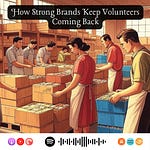Have you ever gotten so lost in a movie that you felt like you were right there with the characters, on the edge of your seat, completely invested? That's the power of storytelling. And it's not just for entertainment. Turns out, you can harness that power to do good in the real world, especially when we're talking about charities and social causes trying to make a difference.
Today, we're diving into research from the Journal of Brand Management to explore how to make storytelling work for these kinds of causes.
This study focused on homelessness as an example but what they found applies to pretty much any cause you can think of (Kaczorowska et al., 2024).
Stories Stick, Facts Fade
Researchers had people read either a personal story about a man named Brian, who was experiencing homelessness, or factual information about homelessness in general.
They then compared how those two groups felt afterwards and what they felt like doing about it. Basically, did they want to help or did they not care? What was the difference?
Fascinatingly, they found that the people who read Brian's story were way more likely to remember it later on. They connected with his experience on a personal level, much more so than the people who just read the facts.
The Two Paths to Action
So stories help people remember, they help people connect, but did the study find that stories made people more likely to help?
That is the million-dollar question, isn't it?
The study found that both the story about Brian and the factual information, both of them led to some willingness to help but in very different ways.
The Brian path: The story about Brian, which played on people's emotions, led to more people wanting to take small, easy actions. Think of it as like low involvement support. Like donating a few dollars or sharing a post on social media.
The facts path: The factual information, which didn't pull at the heartstrings as much, provoked sadness and anger at the situation. These negative emotions actually made people more likely to want to do something bigger, something that takes more effort, like volunteering time or donating a significant amount of money.
It's like two different paths to action. One driven by empathy and one driven by a sense of moral obligation.
The Key Ingredient: Self-Efficacy
But there was a third key finding, which is huge for anyone who wants to use storytelling to make a difference. It turns out it's not enough to just get people riled up, whether it's good vibes or bad vibes. It's about more than just emotion.
The research found that people were more likely to take action when they felt a sense of self-efficacy.
Self-efficacy means people need to believe that their actions can make a difference. You can tell the saddest story in the world, but if people are sitting there thinking, "Well, nothing I do is going to change anything" they're not going to do anything. They'll just feel helpless.
It's about showing them that their actions matter. It's got to be hopeful.
More than that, it's about providing a path for action. It's not enough to just tug at the heartstrings or to make people angry. It's about actually showing them, "Here's what you can do to be a part of the solution".
Give them that sense of agency, like they can actually make a difference. That's what good storytelling can do.
The Big Takeaways
So for anyone listening who's like, "Okay, this is cool and all, but how do I use this?" here are the big takeaways:
Don't be afraid to tell personal stories. Let people connect with the human side of things. Like with Brian. His story made a much bigger impact than just bombarding people with statistics.
Don't forget the facts. You need that balance of emotion and information. It's like "Here's the why, and here's the how."
Make those calls to action feel achievable, bite-sized even. You want people to feel empowered, like they can actually do something to help, even if it's something small.
No guilt trips, no doom and gloom, just a clear path forward. Because when people feel like they have the power to make a difference, that's when real change happens.
And that's what we're all about here, right? Using knowledge and understanding to make the world a better place. Storytelling is a powerful tool for doing just that.
So as you go about your day, just think about where you encounter stories and how you can use that power to make a difference, however big or small. It's all about making connections and inspiring action. And that's what makes this all so fascinating to me.
So until next time, keep exploring, keep asking questions, and keep diving deep into the power of stories.
Quizlet Guide: https://quizlet.com/942456260/harnessing-storytelling-for-social-change-flash-cards/?i=3i62em&x=1jqt
Source:
Kaczorowska, K., Conduit, J. & Goodman, S. Engaging through storytelling: the interplay of engagement with a story, cause, and charity. J Brand Management 31, 265–292 (2024). https://doi.org/10.1057/s41262-023-00343-8












